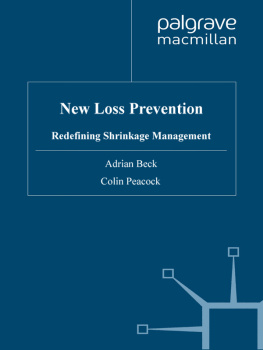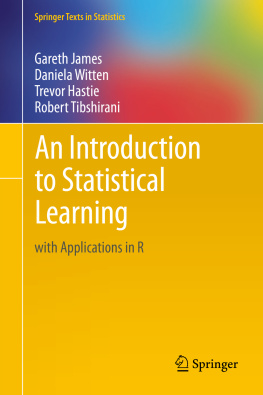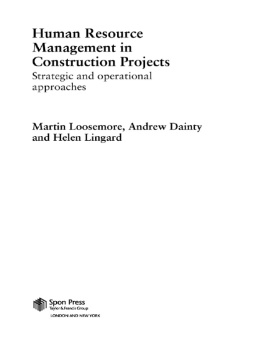New Loss Prevention
New Loss Prevention
Redefining Shrinkage Management
By
Adrian Beck
With
Colin Peacock


Adrian Beck and Colin Peacock 2009
All rights reserved. No reproduction, copy or transmission of this publication may be made without written permission.
No portion of this publication may be reproduced, copied or transmitted save with written permission or in accordance with the provisions of the Copyright, Designs and Patents Act 1988, or under the terms of any licence permitting limited copying issued by the Copyright Licensing Agency, Saffron House, 610 Kirby Street, London EC1N 8TS.
Any person who does any unauthorized act in relation to this publication may be liable to criminal prosecution and civil claims for damages.
The authors have asserted their rights to be identified as the authors of this work in accordance with the Copyright, Designs and Patents Act 1988.
First published 2009 by
PALGRAVE MACMILLAN
Palgrave Macmillan in the UK is an imprint of Macmillan Publishers Limited, registered in England, company number 785998, of Houndmills, Basingstoke, Hampshire RG21 6XS.
Palgrave Macmillan in the US is a division of St Martins Press LLC, 175 Fifth Avenue, New York, NY 10010.
Palgrave Macmillan is the global academic imprint of the above companies and has companies and representatives throughout the world.
Palgrave and Macmillan are registered trademarks in the United States, the United Kingdom, Europe and other countries
ISBN-13: 978-0-230-57583-7 hardback
This book is printed on paper suitable for recycling and made from fully managed and sustained forest sources. Logging, pulping and manufacturing processes are expected to conform to the environmental regulations of the country of origin.
A catalogue record for this book is available from the British Library.
A catalogue record for this book is available from the Library of Congress.
10 9 8 7 6 5 4 3 2 1
18 17 16 15 14 13 12 11 10 09
Printed and bound in Great Britain by
CPI Antony Rowe, Chippenham and Eastbourne
To Sue with Love
List of Figures and Tables
Figures
Tables
List of Abbreviations
ABRAS | Association of Brazilian Supermarkets |
AP | Asset Protection |
CCTV | Closed Circuit Television |
CPTED | Crime Prevention Through Environmental Design |
EAS | Electronic Article Surveillance |
ECR | Efficient Consumer Response |
EPoS | Electronic Point of Sale |
FMCG | Fast Moving Consumer Goods |
FMEA | Failure Mode and Effects Analysis |
GCI | Global Commerce Initiative |
LP | Loss Prevention |
NRSS | National Retail Security Survey |
ORC | Organised Retail Crime |
POS | Point of Sale |
RFID | Radio Frequency Identification |
RIS | Retail Information System |
SKU | Stock Keeping Unit |
UPC | Uniform Product Code |
1
Introduction
The term shrinkage usually refers to something becoming smaller or a gradual contraction over time an impact not considered to be serious or of much concern. Within the world of retailing and loss prevention, however, it has a much more significant meaning although achieving agreement on precisely what that meaning is, as will be discussed in this book, has proven highly illusive for those working in the field or studying the subject. Generally speaking it is used as a catch-all phrase to categorise the financial losses that retailers face through spoilage, damage, error and theft. It incorporates a highly disparate group of activities ranging from apples going out of date to organised gangs of thieves clearing shelves of high value ink jet cartridges. Its scale is truly extraordinary and rarely fails to shock the uninitiated. For instance, the Global Retail Theft Barometer, a survey of retailers which covered 36 countries in Africa, Asia Pacific, Europe, North America and Latin America, provides a relatively recent attempt to measure the scale of the problem and concluded that the annual cost of shrinkage in these countries was $104.5 billion (Bamfield, 2008). Such an enormous number is difficult to comprehend until you consider that it is almost equivalent to the combined Gross Domestic Product (GDP) of two countries Luxembourg and Vietnam (World Bank, 2009). In simplistic terms, every year the retail communities in 36 countries could buy the entire output of two nations with the amount they lose through shrinkage! And as we reveal in this book, total global losses from shrinkage are probably much higher, perhaps equating to as much as $232 billion a year.
It is also a problem that has proved to be stubborn and resistant to the many and varied attempts to reduce its impact on retail profits. Within the industry, shrinkage is usually reported as a percentage of retail turnover and one of the most authoritative and long running shrinkage surveys undertaken by Hollinger and others in the USA shows that the rate of shrinkage has remained relatively unchanged over the last 16 years. His first study in 1991 recorded an overall rate of loss for retailers in the US of 1.79 per cent and the most recent survey covering 2007 calculated that it was 1.44 per cent a historic low but still a relatively modest reduction compared with the first survey (Hollinger & Adams, 2008). However, it has not been a straightforward downward linear progression and this annual security survey has shown much fluctuation in the cost of shrinkage with a peak in 1994 of 1.95 per cent. And if we head back a little further in time, studies undertaken in the second half of the last century reported rates not that dissimilar to some of those that have been completed in the last few years with averages of between 1.5 per cent and 2 per cent (Curtis, 1960, 1983; Baumer & Rosenbaum, 1984; National Supermarket Research Group, 2003).
Understanding why shrinkage has proven to be such a resilient and long lasting problem for the retail industry is one of the main reasons for writing this book. The loss prevention industry is a multi-billion dollar global business that is increasingly developing and making use of some of the most sophisticated and cutting edge technologies, including biometrics, surveillance systems, digital recognition and data analytics. Our estimates suggest that globally, retailers could be spending as much as $46.4 billion a year on trying to tackle the problem of shrinkage, which when combined with our estimate of the cost of shrinkage, would produce a total shrinkage bill of some $278 billion a year, almost equivalent to the GDP of Denmark. Why does shrinkage cost so much and why do the current approaches to deal with the problem seem to be at best holding back the tide of loss? Perhaps more importantly, is there a better way to deal with the problem of shrinkage that may have a more lasting impact on the scale and extent of the problem? These are the key questions that this book would like to address.
Next page










